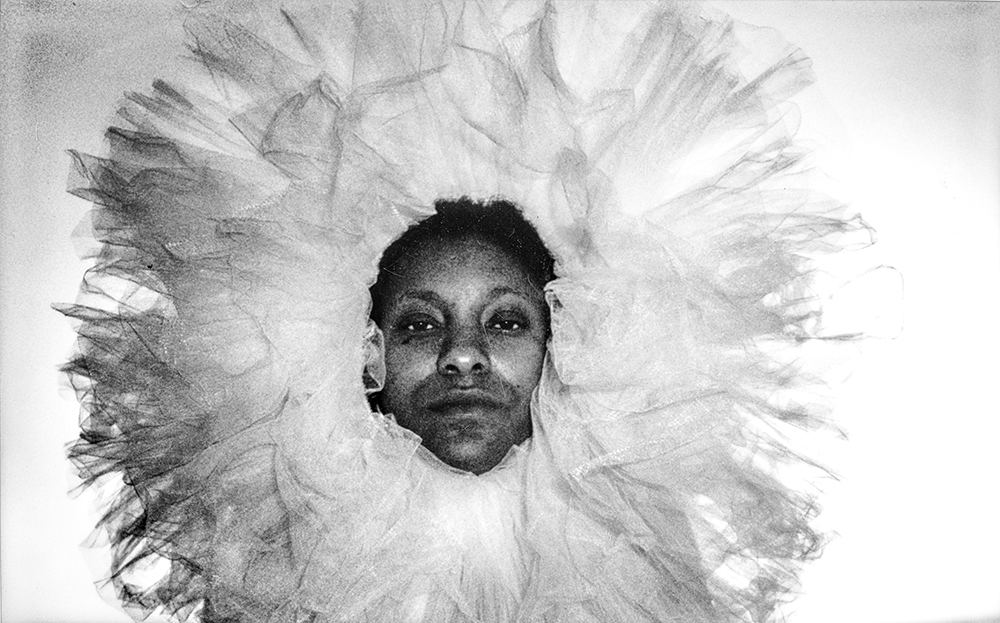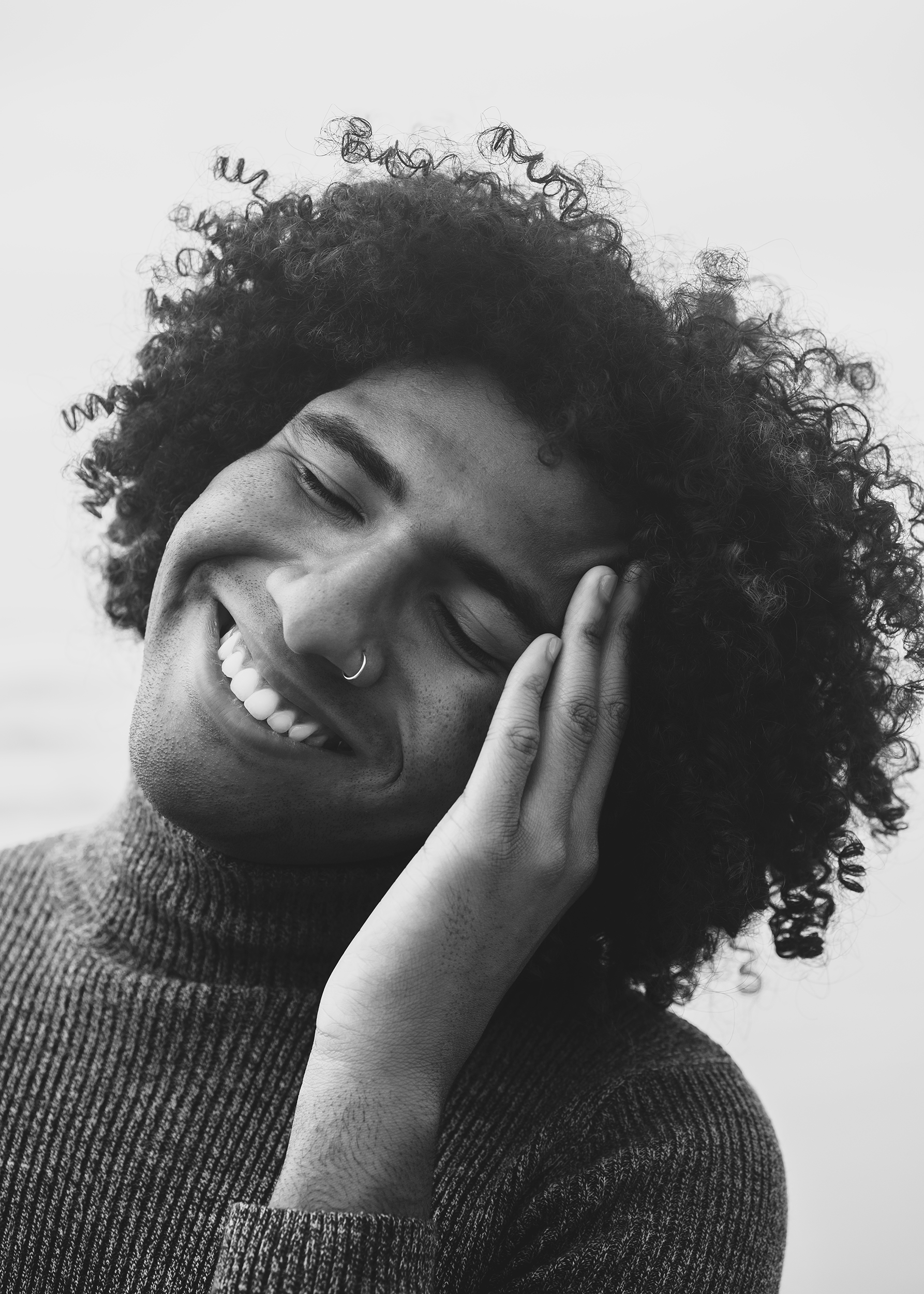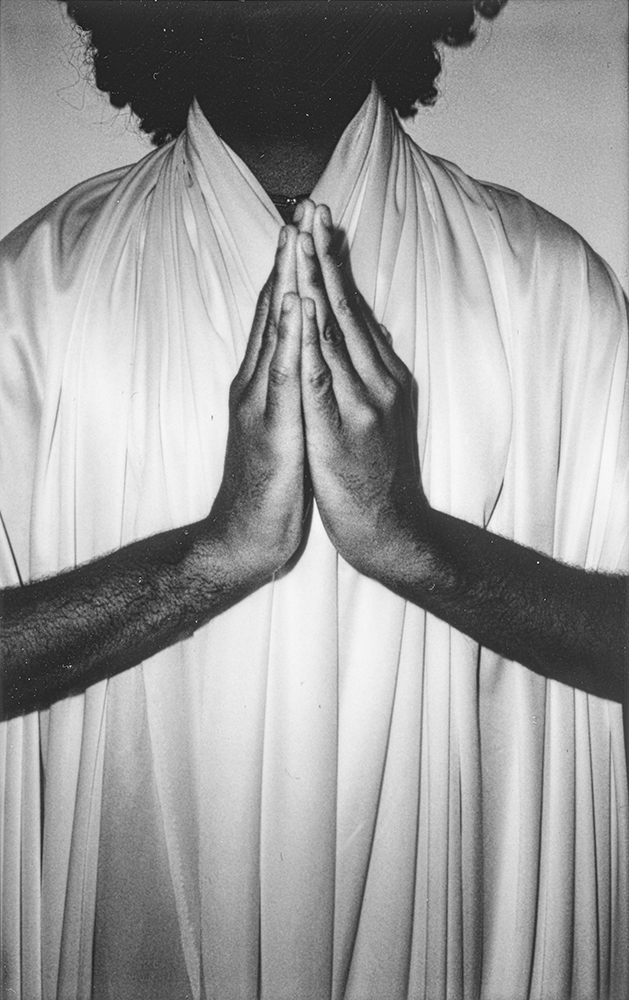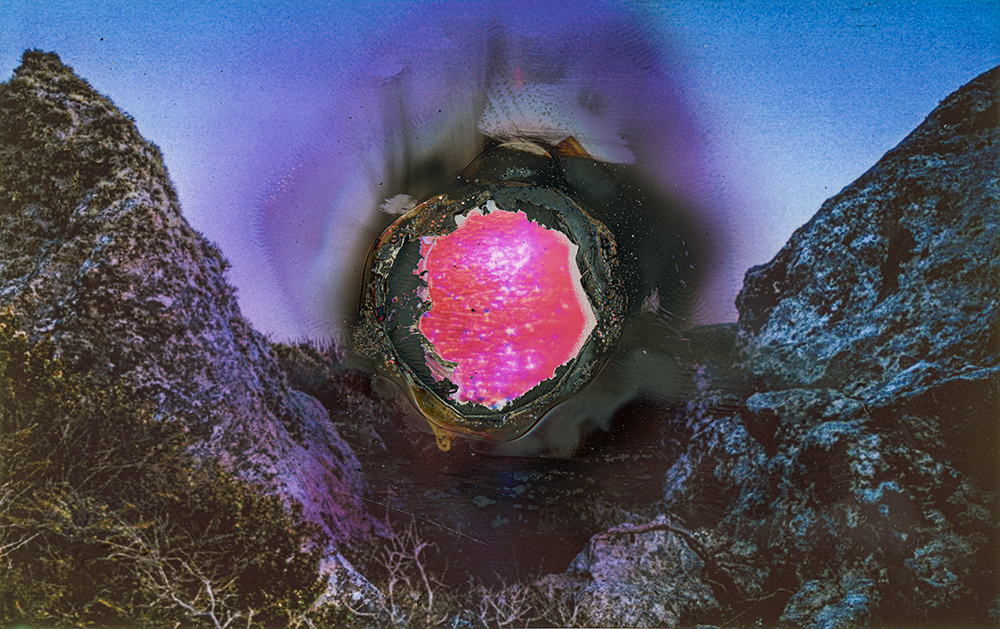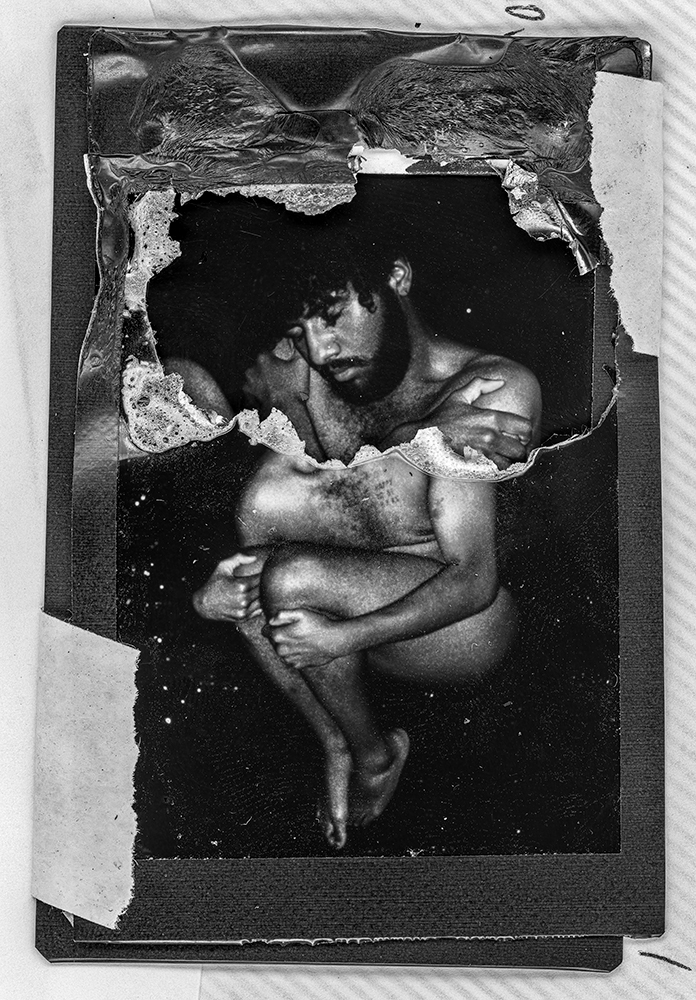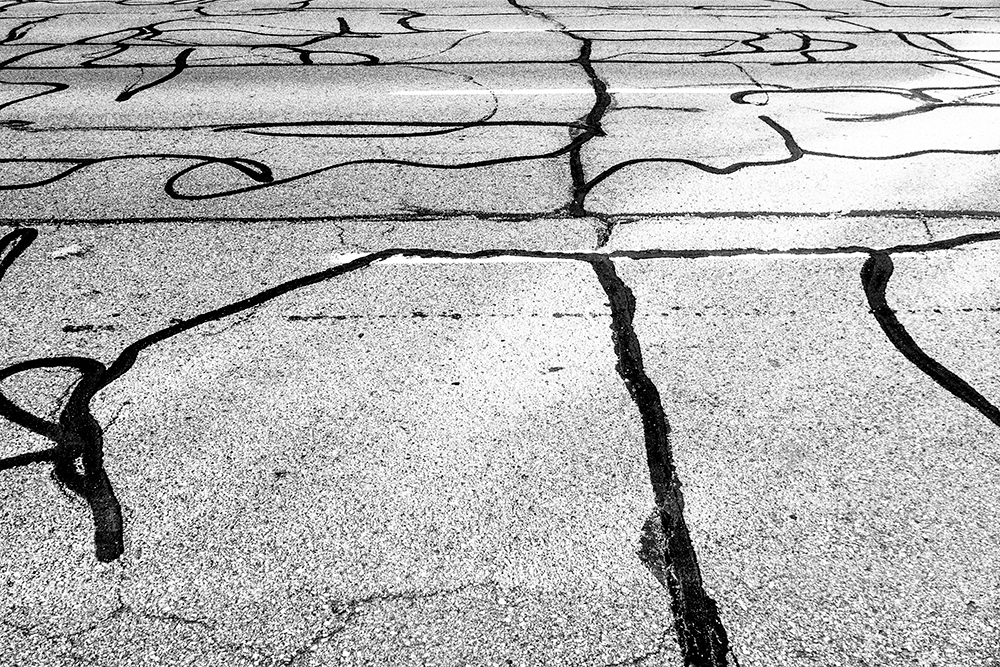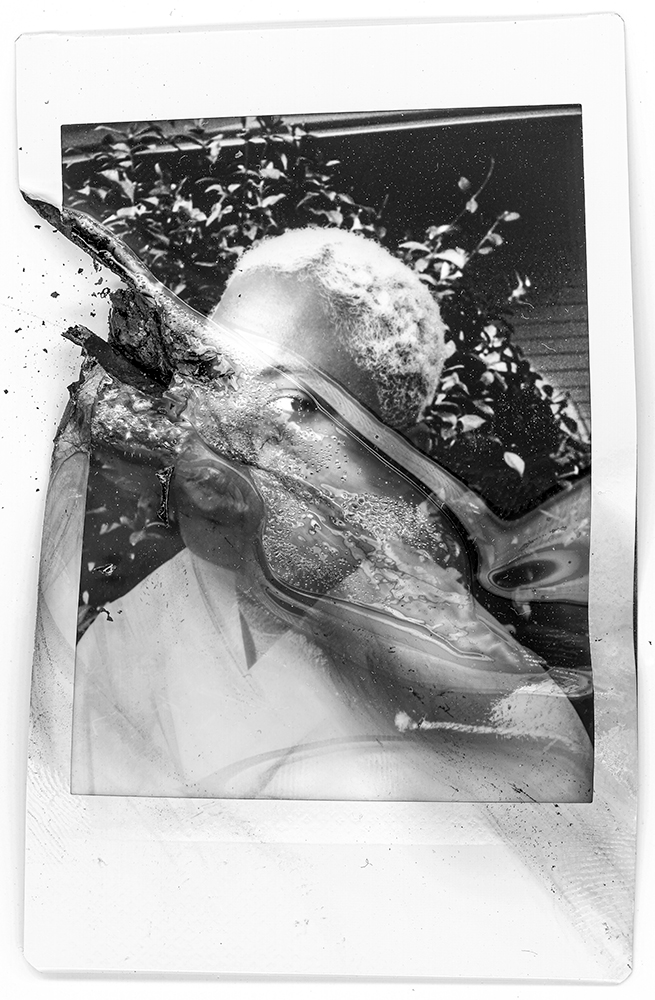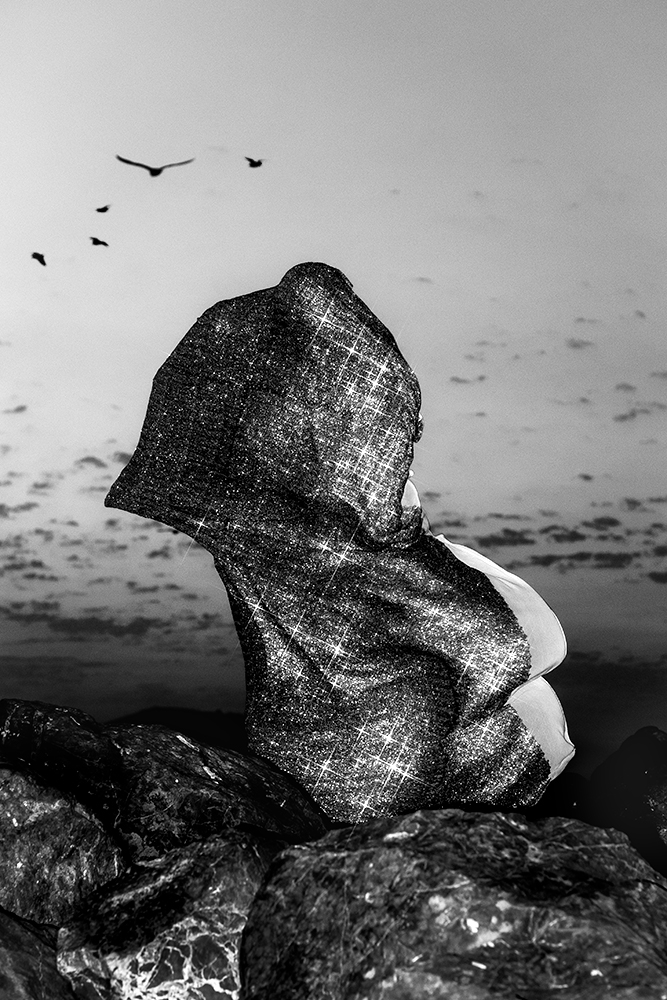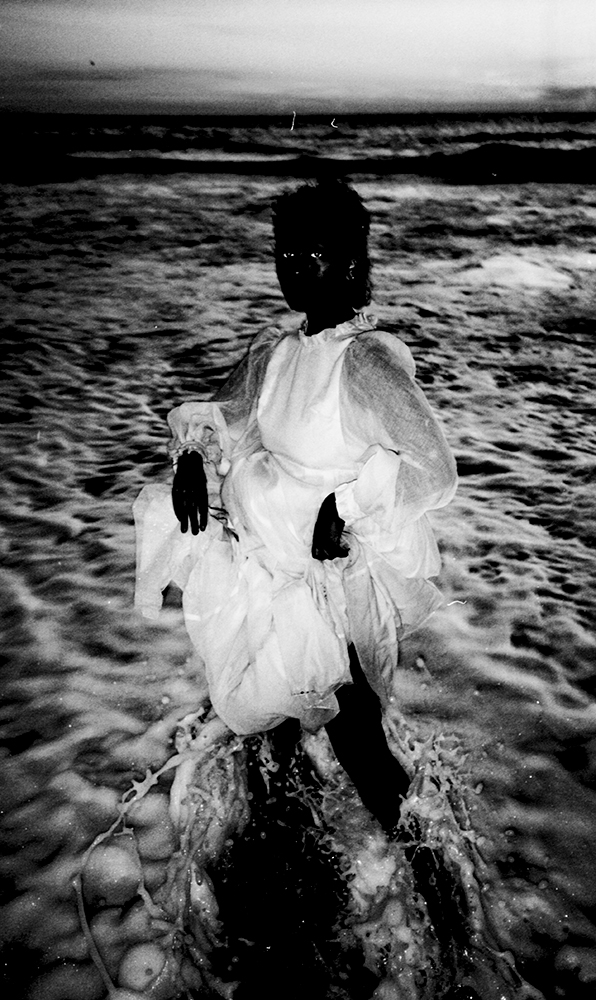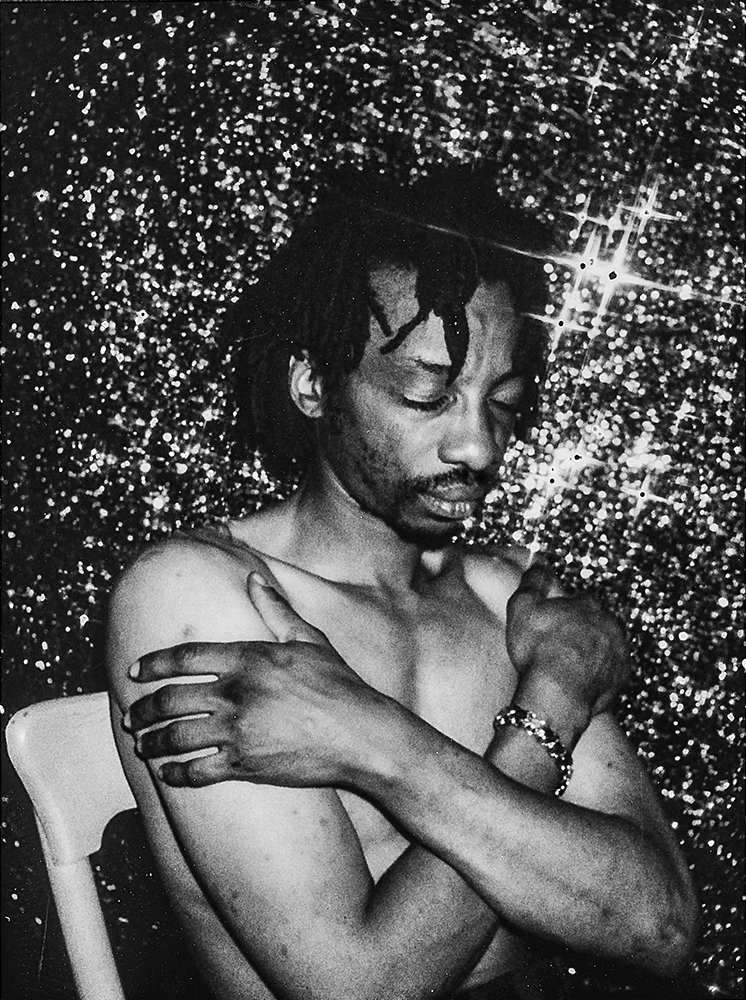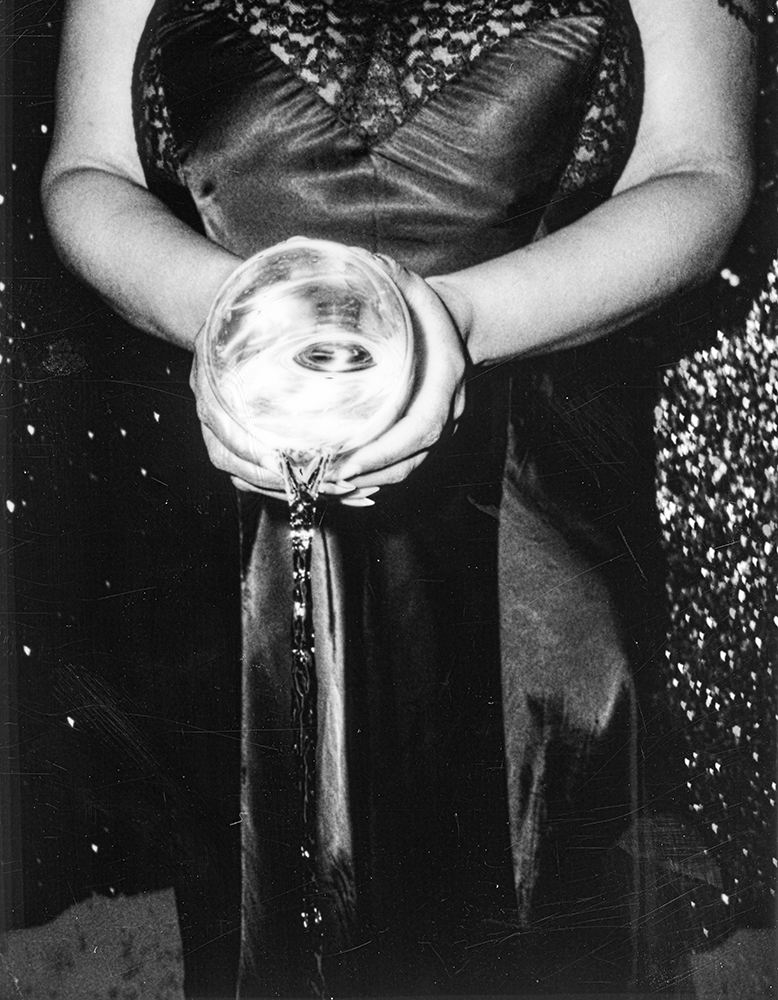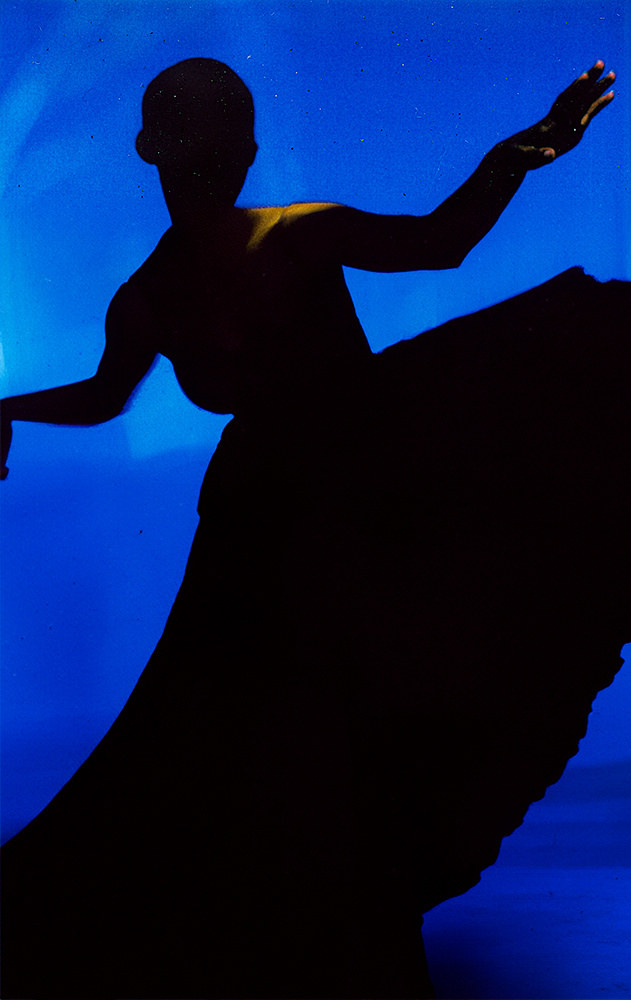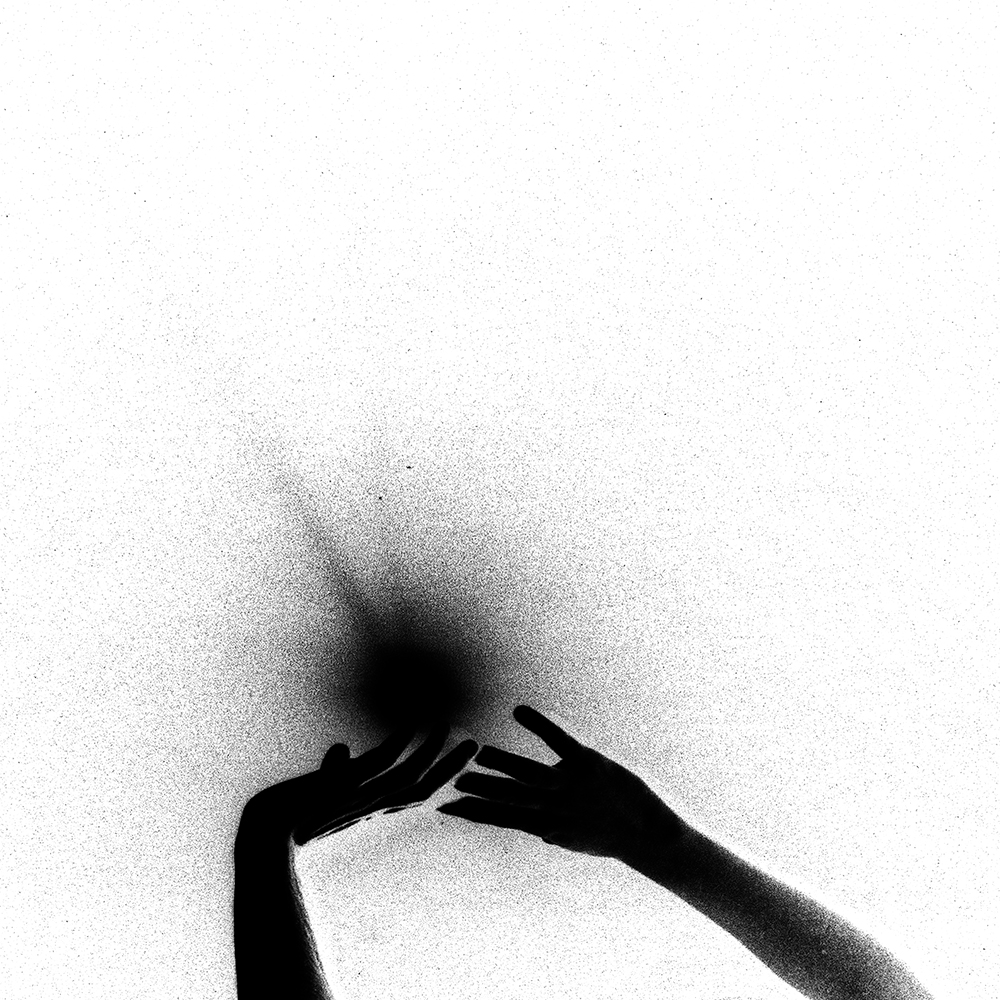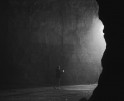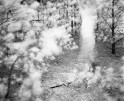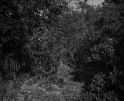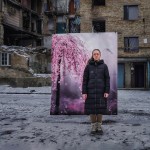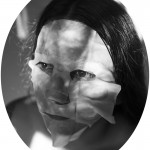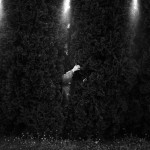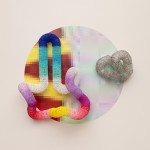The 2023 Lenscratch Student Prize 2nd Place Winner: Nykelle DeVivo
It is with pleasure that the jurors announce the 2023 Lenscratch Student Prize 2nd Place Winner, Nykelle DeVivo. DeVivo was selected for their project, tha crossroads, and is currently attending the University of California San Diego MFA in Visual Art. The 2nd Place Winner receives a $750 cash prize, a feature on Lenscratch , a mini exhibition on the Curated Fridge, and a a Lenscratch T-shirt and Tote.
In their series, tha crossroads, Nykelle Devivo visualizes an intriguing representation of the space between the physical and spiritual world. They write that this is a “personal meditation” informed by a deeply religious upbringing. For me, the images feel like thresholds—bridging the gap between terrestrial familiarity and something celestial. DeVivo states that this body of work demonstrates “a lifetime of reverence for the divine while simultaneously bearing the cross of anti-Blackness that saturates our relationship to the land. In that, they work as a form of escapism in the hopes of a new world to come.”
Along with visual and conceptual nods to Afrofuturism, DeVivo’s use of photography as an amplification of their spiritual practice adds an intriguing layer to these images. I am fascinated by the figures, objects, and natural elements, and how they urge me to muse on the photographic medium’s ability to make connections between the tangible and the intangible aspects of the human experience. However, the strength of these photographs lies in their specificity and sincerity regarding the state of Black and trans/queer existence. As DeVivo notes later on in our conversation, “I work to physicalize (or birth) the truths of our higher selves through the authoritative nature of the medium.” This sentiment facilitates a moving vision—of resilience, and of a yearning for a brighter future.
At the end of their artist statement, DeVivo writes of portals and entrances. As viewers, we are given access—to look and enter heartfelt perception of the sacred through symbolism, emotional resonance, and a connection to the divine. We are encouraged to explore and reflect within the photographic frame, which DeVivo has designated as a hallowed space.
 An enormous thank you to our jurors: Aline Smithson, Founder and Editor-in-Chief of Lenscratch, Educator and Artist, Daniel George, Submissions Editor of Lenscratch, Educator and Artist, Linda Alterwitz, Art + Science Editor of Lenscratch and Artist, Kellye Eisworth, Managing Editor of Lenscratch, Educator and Artist, Alexa Dilworth, publishing director, senior editor, and awards director at the Center for Documentary Studies (CDS) at Duke University, Kris Graves, Director of Kris Graves Projects, photographer and publisher based in New York and London, Elizabeth Cheng Krist, Former Senior Photo Editor with National Geographic magazine and founding member of the Visual Thinking Collective, Hamidah Glasgow, Director of the Center for Fine Art Photography, Fort Collins, CO, Yorgos Efthymiadis, Artist and Founder of the Curated Fridge, Drew Leventhal, Artist and Publisher, winner of the 2022 Lenscratch Student Prize, Allie Tsubota, Artist and Educator, winner of the 2021 Lenscratch Student Prize, Raymond Thompson, Jr., Artist and Educator, winner of the 2020 Lenscratch Student Prize, Guanyu Xu, Artist and Educator, winner of the 2019 Lenscratch Student Prize, Shawn Bush, Artist, Educator, and Publisher, winner of the 2017 Lenscratch Student Prize.
An enormous thank you to our jurors: Aline Smithson, Founder and Editor-in-Chief of Lenscratch, Educator and Artist, Daniel George, Submissions Editor of Lenscratch, Educator and Artist, Linda Alterwitz, Art + Science Editor of Lenscratch and Artist, Kellye Eisworth, Managing Editor of Lenscratch, Educator and Artist, Alexa Dilworth, publishing director, senior editor, and awards director at the Center for Documentary Studies (CDS) at Duke University, Kris Graves, Director of Kris Graves Projects, photographer and publisher based in New York and London, Elizabeth Cheng Krist, Former Senior Photo Editor with National Geographic magazine and founding member of the Visual Thinking Collective, Hamidah Glasgow, Director of the Center for Fine Art Photography, Fort Collins, CO, Yorgos Efthymiadis, Artist and Founder of the Curated Fridge, Drew Leventhal, Artist and Publisher, winner of the 2022 Lenscratch Student Prize, Allie Tsubota, Artist and Educator, winner of the 2021 Lenscratch Student Prize, Raymond Thompson, Jr., Artist and Educator, winner of the 2020 Lenscratch Student Prize, Guanyu Xu, Artist and Educator, winner of the 2019 Lenscratch Student Prize, Shawn Bush, Artist, Educator, and Publisher, winner of the 2017 Lenscratch Student Prize.
Nykelle DeVivo is a southern California visual artist working primarily with lens based mediums to explore the crossroads between the physical world and that of our ancestors. Employing the languages of Afrofuturism, queer/trans expression and alter work, Nykelle uses their art as an extension of their spiritual practice. They studied theory & photography at the San Francisco Art Institute before going on to have their works acquired by permanent museum collections across the country, becoming an inaugural Google Image Equity Fellow, and exhibiting their images in numerous exhibitions. Nykelle is currently pursuing their MFA in visual art from the University of California San Diego where they expect to graduate in 2025.
Instagram: @nykelle_devivo
tha crossroads (2013-2023)
My practice is a personal meditation on the liminal space between our world and that of spirit. Less interested in the destination, my photographs work to document the shift. The moments between moments of time, the pause between the clap.
Raised in a deeply religious household and honoring the language of afro spiritualism, my images reflect a lifetime of reverence for the divine while simultaneously bearing the cross of anti-Blackness that saturates our relationship to the land. In that, they work as a form of escapism in the hopes of a new world to come.
In my images, Black is potentiality. In the shine, there is god, and in fire, there is change. The concurrent states of Black existence (the past, the present, and our futures) can collapse in a singular moment, and image-making has the power to bear witness. The camera can act as a space for the refusal of a history of violence in that it may be used as a tool for communion.
Now I find spirit in the collective hopes we place on a pair of sneakers, the way flowers reach for the sun, and the eyes of those I love. All can act as a portal to other worlds and an entrance for spirit unto ours. – Nykelle DeVivo
Daniel George: Congratulations on 2nd Place for the Lenscratch Student Prize!!! To start off, tell us about your beginnings in photography. What brought about your interest in the medium?
Nykelle DeVivo: Firstly, I’m honored to receive this award as I’ve been a follower of Lenscratch since I was a teenager. Photography has always seemed like my path as I have photos of myself at two years old staring at a camera with love in my eyes, then I received my first toy Polaroid at four and I haven’t put it down since. My mother ran a large spiritual retreat center and is well known (and contested) for receiving messages from her guru years after his death. As a child, I casually shot a Polaroid where the deceased guru appeared under a tree I was photographing. I suppose I’m interested in the lineage of spirit workers in my family, but I’m primarily obsessed with the medium’s magical potentiality.
DG: How about tha crossroads, specifically? When and how did that work start?
ND: I had a studio visit with the painter and muralist, Dewey Crumpler where he commented that my early work, without me having the language at the time, was directly in conversation with African cosmologies. Looking again through my archives I found that the photos I couldn’t explain, the ones you take that feel like gifts, were intrinsically Black which meant to me that there are ways of seeing that are a part of our nature in the same way people of the diaspora have rhythm in our blood. Though I was raised away from my culture in rural Nebraska, the images I made at seventeen running naked through prairie land with a flash, felt like a form of praise to spirits I unconsciously knew were ever-present. Ten years into tha crossroads, I’m still learning to honor when images reveal themselves to me and envision my ancestors through our own language.
DG: I thought that it was interesting how you describe these images as “the pause between the clap.” What draws you to the “moments between moments?” What sort of magnitude do these junctures hold?
ND: My practice revolves around the Kongo Cosmogram (or the Yowa Cross) which is an African symbol representative of the never-ending cycle from life to death to spirit to birth to life and so on. Its existence proves that we kept our connection to our ancestral religious practices as we found it in the new world engraved in the cabins of enslaved people as well as codified throughout the diaspora in the symbology used by Black spiritual practitioners forced to convert to catholicism. At the center of the cross is harmony (or consciousness). I experience the “pause between the clap” when creating, as there are typically moments of quiet clarity leading up to the creation of images in my project that, to me, are representative of being tapped into the divine consciousness at the center of all things. Myself when I’m real.
DG: What kind of research did you do for this project?
ND: I owe a lot to the Japanese photographers of PROVOKE, as my early research attempted to tie their philosophies of image-making to the possibility of a Black aesthetic within photography that is unburdened by representation. But more loosely my practice is informed by a history of Black imagination, of decolonial hacking, of conversations with my ancestors, of altar work, of praise. My images are informed by musicians such as Sun Ra, Parliament-Funkadelic, Laraaji, and Moor Mother. Thinkers such as Robert Farris Thompson, Saidiya Hartman, and Krista Thompson. And by those around me who I love, and who love me dearly.
DG: Your image “home” illustrates an embrace between two individuals—a physical gesture of affection, that for me, highlights the theme of hope that you write about in your statement. Would you elaborate on the idea of this work (and perhaps the camera) acting as a “tool for communion?”
ND: Thinking again of the Kongo Cosmogram; for years my practice focused on the potential for death as a transitory return home (or luvemba) as I desired to make sense of the gratuitous violence I witnessed Black people enduring around me. Only recently, with the amount of love poured into me by my community, have I begun to envision the opposite end of the Cosmogram, conception, and ultimately, birth (kala). As most of the sitters in my photographs are trans/queer (including myself), I work to physicalize (or birth) the truths of our higher selves through the authoritative nature of the medium. The camera works as a “tool for communion” in that it can work as a guiding thread as we weave between the physical world and that of spirit, which is where the healer works at the crossroads. home is then a self-portrait intertwined with my partner that represents the safety and love of the world I desire to see manifest, it’s both our reality and a dream, a future and a past.
DG: I’d like to hear more about your educational experience. How did your creative practice evolve while you were in school?
ND: I’m currently in an MFA program that has multiple prominent Black faculty as well as a majority BIPOC student body which has been instrumental to my growth and mental well-being. Being able to have casual conversations about a worldview without having to explain cultural contexts has allowed me to focus solely on the work. I came from a predominantly white undergraduate program where the history of photography taught to us was rooted in extraction, violence, and anti-Blackness. I learned that it’s okay to make work for a specific audience and that it’s okay to gatekeep as a means to protect your community. Though white people can appreciate my work, I’ve only seen true understanding and care from other Black (and mostly queer) viewers.
DG: Was there any advice that you received (in the form of a critique, or something else) that you feel had a significant impact on the trajectory of your work? Would you mind sharing?
ND: I had a professor who was deep in The Bay Area’s jazz scene back in its heyday say I was on some “freak shit.” They explained that the title of freak is for when Black artists are tapped into something so beyond them that the art begins to act as a form of channeling. My most successful works came from falling into that energy, as I often feel as if in a trance when dawning my sequin fabrics for self-portraits or when I’m physically collaging my polaroids. When a piece is successful I regularly say “That’s some freaky ass shit” cause there’s no way I could’ve thought it into existence.
DG: Being a student can be exhausting, and burnout is real. What motivates you to keep creating?
ND: Every time I’ve even considered walking away from this life spirit has reminded me that I’m meant to be an artist. I’m grateful to say that creating gives me energy and I wake up excited most days to learn more about my practice. The bureaucracy and blatant anti-Blackness of the art world exhausts me though as I’m regularly reminded of the saying that Black folk have to work twice as hard for half as much. Recently I read Rest Is Resistance by Tricia Hersey, which is a reminder that there’s no need to break our backs trying to be more productive for a system that doesn’t care for us, as it’s far more radical to move at our pace and simply be.
DG: To wrap things up, is there a mentor that you’d like to acknowledge?
ND: I’d love to give my thanks to my mentors in The Bay who took me under their wing as a teenager, April Martin, Wesaam Al-Badry, and Ben Jones. As well as my current advisors at UCSD, Paul Mpagi Sepuya and Nicole Miller.
Posts on Lenscratch may not be reproduced without the permission of the Lenscratch staff and the photographer.
Recommended
-
The 2023 Lenscratch Student Prize Honorable Mention Winner: Tristan SheldonJuly 30th, 2023
-
The 2023 Lenscratch Student Prize Honorable Mention Winner: Hannah NigroJuly 29th, 2023
-
The 2023 Lenscratch Student Prize Honorable Mention Winner: Elena Bulet i LlopisJuly 28th, 2023
-
The 2023 Lenscratch Student Prize Honorable Mention Winner: Paola ChapdelaineJuly 27th, 2023
-
The 2023 3rd Place Lenscratch Student Prize Winner: Anna RottyJuly 26th, 2023

